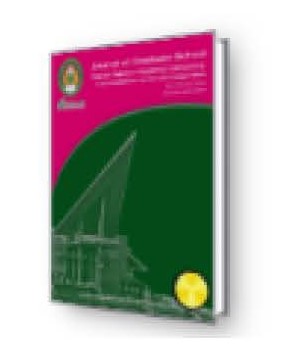การวิจัยเชิงปฏิบัติการในชั้นเรียนเพื่อพัฒนาผลสัมฤทธิ์ทางการเรียนความสามารถในการแก้โจทย์ปัญหาและเจตคติต่อวิชาคณิตศาสตร์ โดยใช้แบบฝึกทักษะการแก้โจทย์ปัญหาคณิตศาสตร์ตามขั้นตอน ของโพลยาร่วมกับรูปแบบการสอนโมเดลซิปปา
บทคัดย่อ
บทคัดย่อ
การวิจัยครั้งนี้ มีความมุ่งหมายเพื่อ 1) ศึกษาสภาพปัญหาในการเรียนการสอนคณิตศาสตร์ 2)ศึกษาแนวทางในการพัฒนาผลสัมฤทธิ์ทางการเรียนความสามารถในการแก้โจทย์ปัญหา และเจตคติต่อวิชาคณิตศาสตร์ 3) สะท้อนผลการพัฒนาการเรียนการสอนคณิตศาสตร์ด้วยแบบฝึกทักษะการแก้โจทย์ปัญหาตามขั้นตอนของโพลยาร่วมกับรูปแบบการสอนโมเดลซิปปาในการพัฒนาด้านผลสัมฤทธิ์ทางการเรียน ความสามารถในการแก้โจทย์ปัญหา และเจตคติต่อวิชาคณิตศาสตร์ กลุ่มเป้าหมายเป็นนักเรียนชั้นประถมศึกษาปีที่ 6 โรงเรียนบ้านหนองบัวบาน ภาคเรียนที่ 2 ปีการศึกษา 2554 จำนวน 10 คนเครื่องมือที่ใช้ในการวิจัยประกอบด้วย 1) แบบฝึกทักษะการแก้โจทย์ปัญหาคณิตศาสตร์ตามขั้นตอนของโพลยาร่วมกับรูปแบบการสอนโมเดลซิปปา 2) แบบทดสอบวัดผลสัมฤทธิ์ทางการเรียน 3) แบบทดสอบวัดความสามารถในการแก้โจทย์ปัญหาคณิตศาสตร์ 4) แบบวัดเจตคติต่อวิชาคณิตศาสตร์ สถิติที่ใช้ในการวิเคราะห์ข้อมูล ได้แก่ ค่าเฉลี่ย ส่วนเบี่ยงเบนมาตรฐานหาประสิทธิภาพของแบบฝึกทักษะการแก้โจทย์ปัญหาคณิตศาสตร์ตามขั้นตอนของโพลยาร่วมกับรูปแบบการสอนโมเดลซิปปา ค่าสัมประสิทธิ์ความแปรผัน ค่าดัชนีประสิทธิผล สถิติทดสอบค่าที
ผลการวิจัยสรุปได้ดังนี้
1. สภาพการจัดการเรียนการสอนครู 1 คนต้องรับผิดชอบการสอนนักเรียนต่อ 2 ระดับชั้น สภาพปัญหาในการจัดการเรียนการสอนคณิตศาสตร์ มีดังนี้ 1.1) ด้านเนื้อหาสาระ1.2) ด้านครูผู้สอน1.3) ด้านตัวผู้เรียน
2. แนวทางในการพัฒนาผลสัมฤทธิ์ทางการเรียนความสามารถในการแก้โจทย์ปัญหาและเจตคติต่อวิชาคณิตศาสตร์ พัฒนาโดยใช้แบบฝึกทักษะการแก้โจทย์ปัญหาตามขั้นตอนของโพลยาร่วมกับรูปแบบการสอนโมเดลซิปปา
3. ผลการพัฒนาการเรียนการสอนคณิตศาสตร์โดยใช้แบบฝึกทักษะการแก้โจทย์ปัญหาตามขั้นตอนของโพลยาร่วมกับรูปแบบการสอนโมเดลซิปปา มีดังนี้ 3.1) แบบฝึกทักษะการแก้โจทย์ปัญหาตามขั้นตอนของโพลยาร่วมกับรูปแบบการสอนโมเดลซิปปามีค่า สัมประสิทธิ์ความแปรผัน C.V.= 8.82 มีคุณภาพโดยรวมในระดับดีเยี่ยม 3.2) ดัชนีประสิทธิผล (Effectiveness Index : E.I.) ของแบบฝึกทักษะการแก้โจทย์ปัญหาตามขั้นตอนของโพลยาร่วมกับรูปแบบการสอนโมเดลซิปปาพิจารณาจากการทดสอบวัดผลสัมฤทธิ์ทางการเรียนมีค่าดัชนีประสิทธิผลเท่ากับ 0.65 และเมื่อพิจารณาจากการทดสอบวัดความสามารถในการแก้โจทย์ปัญหามีค่าดัชนีประสิทธิผลเท่ากับ 0.64 3.3) ผลการเปรียบเทียบผลสัมฤทธิ์ทางการเรียนของนักเรียนที่เรียนโดยใช้แบบฝึกทักษะการแก้โจทย์ปัญหาตามขั้นตอนของโพลยาร่วมกับรูปแบบการสอนโมเดลซิปปาหลังเรียนสูงกว่าก่อนเรียนอย่างมีนัยสำคัญทางสถิติที่ระดับ .01 3.4) ผลการเปรียบเทียบความสามารถในการแก้โจทย์ปัญหาของนักเรียนที่เรียนโดยใช้แบบฝึกทักษะการแก้โจทย์ปัญหาตามขั้นตอนของโพลยาร่วมกับรูปแบบการสอนโมเดลซิปปาหลังเรียนสูงกว่าก่อนเรียนอย่างมีนัยสำคัญทางสถิติที่ระดับ .01 3.5)ผลการเปรียบเทียบเจตคติต่อวิชาคณิตศาสตร์ของนักเรียนที่เรียนโดยใช้แบบฝึกทักษะการแก้โจทย์ปัญหาตามขั้นตอนของโพลยาร่วมกับรูปแบบการสอนโมเดลซิปปาหลังเรียนสูงกว่าก่อนเรียนอย่างมีนัยสำคัญทางสถิติที่ระดับ .01
ABSTRACT
This student aimed 1) to investigate the problem in learning Mathematics of Prathom Suksa 6, 2) to investigate to Development of Academic Achievement Ability to Solve Problems and Attitudes toward Mathematics of Prathom Suksa 6, 3) to reflect the Development of Teaching and Learning Mathematics with Practical problem Solving Steps of Polya with CIPPA Model. In the Development of Academic Achievement, the Ability to Solve Problems, and Attitudes toward Mathematics of Students of Prathom Suksa 6. The target group consisted of 10 Prathom Suksa 6 students in the second semester of academic year. The tools used in this study were composed of: 1) the Practice Mathematical problem solving of Polya steps with CIPPA Model, 2) a test of mathematical achievement, 3) a test of the abilities to solve problems, 4) a test to measure Attitude toward mathematics. Data were statistically analyzed using percentage, mean and standard deviation, Coefficient of Variance (C.V.), and t-test (Dependent Samples).
The findings of this study were as follows :
1. The Conditions for teaching one teacher was responsible for teaching students with two classes of problems in the teaching and learning of mathematics included: 1.1) the Problem the contents, 1.2) the problem on the teachers, 1.3) the problem on the students.
2. The guidelines to development achievement, the ability to solve problems, and attitudes toward mathematics of Prathom suksa 6 by using the skills of problem solving by Polya process with CIPPA Model.
3. The implementation of the development of the Practice Problems with steps of Polya in Conjunction with CIPPA Model comprised: 3.1) The Coefficient of Variance measured by the tests from the end of each lesson plan gained a high quality as set. (C.V. = 8.82), 3.2) Effectiveness Index of the skills problem solving steps of Polya with CIPPA model considering the achievement and effectiveness index was 0.65, and considering the test. the ability to solve problems, the effectiveness index is 0.61. 3.3) After learning, the students’ achievements in learning mathematics using the Practice Problems with steps of Polya in Conjunction with CIPPA Model were higher than before learning at the .01 level of significance, 3.4) The students’ abilities to solve the problems, after learning, using the
Practice Problems with steps of Polya in Conjunction with Cippa Model were higher than prior to learning at the .01 level of significance, 3.5) After learning, the students’ attitudes toward mathematics using the Practice Problems with steps of Polya in Conjunction with CIPPA Model were higher than before learning at the .01 level of significance.
ดาวน์โหลด
เผยแพร่แล้ว
รูปแบบการอ้างอิง
ฉบับ
ประเภทบทความ
สัญญาอนุญาต
บทความทุกบทความที่ตีพิมพ์ในวารสารบัณฑิตศึกษา มหาวิทยาลัยราชภัฏสกลนคร ถือว่าเป็นลิขสิทธิ์ของบัณฑิตวิทยาลัย มหาวิทยาลัยราชภัฏสกลนคร





